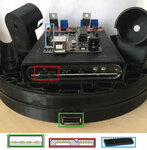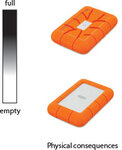wizman
Junior Member level 1

Hello Everyone,
Small caveat to begin, I'm a product design student with very basic knowledge regarding electronics and coding, which is worth keeping in mind if i use some technical terms out of place.
For context, I'm proposing to build an inflatable hard drive. I have code* which reads the amount of data on the hard drive, and outputs this number as serial data which can be read by the arduino. The arduino would then, in theory, power one of two pumps for x amount of time, either inflating or deflating a balloon. Ideally, you would use the device in the same way you do an external hard drive e.g. plug your computer in via USB and transfer data. With the exception that this one inflates or deflates a certain amount depending on the amount of data you either add or remove
Both the code that serially outputs the hard drives capacity and the arduino code shouldn't be an issue. However, I don't know how to transfer the 'information' between devices with a single USB port

Thinking it through in steps gives me this flow of information.
I'm under the impression that the flow of electricity can be thought of in basic terms as similar to that of water. In which case i'm looking for a hub like component that redirects the flow of information from the hard drive to the arduino when that information is transmitted serially. Does this exist?
*The code was written with the help of a technician in node.js, a language I have zero experience in. Here is the github of some of this code https://github.com/wisemanlove/IHD taken from this folder
please let me know if it would be helpful to see more code.
Small caveat to begin, I'm a product design student with very basic knowledge regarding electronics and coding, which is worth keeping in mind if i use some technical terms out of place.
For context, I'm proposing to build an inflatable hard drive. I have code* which reads the amount of data on the hard drive, and outputs this number as serial data which can be read by the arduino. The arduino would then, in theory, power one of two pumps for x amount of time, either inflating or deflating a balloon. Ideally, you would use the device in the same way you do an external hard drive e.g. plug your computer in via USB and transfer data. With the exception that this one inflates or deflates a certain amount depending on the amount of data you either add or remove
Both the code that serially outputs the hard drives capacity and the arduino code shouldn't be an issue. However, I don't know how to transfer the 'information' between devices with a single USB port

Thinking it through in steps gives me this flow of information.
- Computer is connected to hard drive via USB port
- File is uploaded to hard drive
- Code ascertains change in hard drive capacity and converts this to serial data
- Computer sends serial data to arduino via USB port
I'm under the impression that the flow of electricity can be thought of in basic terms as similar to that of water. In which case i'm looking for a hub like component that redirects the flow of information from the hard drive to the arduino when that information is transmitted serially. Does this exist?
*The code was written with the help of a technician in node.js, a language I have zero experience in. Here is the github of some of this code https://github.com/wisemanlove/IHD taken from this folder
please let me know if it would be helpful to see more code.


